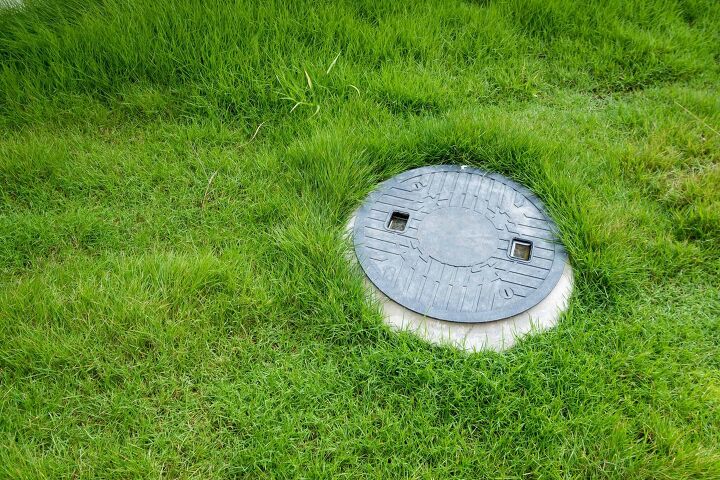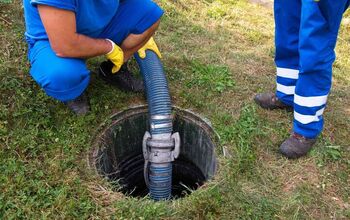What Is The Difference Between A Septic Tank And A Cesspool?

Nobody likes to think about what happens after we flush the toilet. In many places, a public sewer system whisks away our waste without much thought. But for others, septic systems and cesspools do the dirty work.
Septic tanks store solid and liquid waste and use bacteria to break them down. Cesspools are different because they hold solid waste and allow liquid waste to seep into the soil. Septic tanks are considered better because they require less maintenance and are ideal for large homes.
Both septic tanks and cesspools serve areas where hooking into municipal sewer systems is impractical or impossible. They are especially common in rural areas. While the differences may sound subtle, the two systems have very different rules, regulations, and applications.
Do You Need a Septic System Installation or Replacement?
Get free, zero-commitment quotes from pro contractors near you.

What’s In Waste?
The human waste that ends up in a sewer, septic tank, or cesspool has three components:
- Scum is less dense than water and is biodegradable. It floats on the surface.
- Effluent is the wastewater itself. This liquid can safely be released into the surrounding soil.
- Sludge is waste that’s heavier than water. It sinks to the bottom and is not biodegradable. That means sludge needs to be pumped out at regular intervals.
All waste management systems share the same goal of processing organic waste into these three categories.
How Are Septic Tanks And Cesspools Similar?
Both septic tanks and cesspools disperse household wastewater into your yard. A cesspool releases it into a specific area, while a septic tank spreads out the effluent to a larger soil area.
The two systems require similar maintenance. They both need to be pumped every 3-5 years. This timing depends on the number of people in your household and how much water is used. Basically, the heavier the usage, the more frequently the tanks will need to be emptied.
Another factor is garbage: how much material is put into the system other than human waste? If foreign, inorganic material finds its way into the septic tank or cesspool, it can cause backups and clogs.
Both systems can last anywhere from 25 to 40 years with proper maintenance and care. The kinder you are to the system, the kinder it will be to you.
If either kind of tank becomes too full, it can cause a backup that floods your yard or house with sewage. This is not only unpleasant and unsightly but can cause some very expensive damage.
All About Cesspools
History of Cesspools
Cesspools, also known as leaching pools, date back to ancient times. They were invented alongside the first pipes in Rome and Babylonia.
A cesspool is a cylindrical pit made of cement or stone that collects human and household waste. Older versions were rectangular and made of cinderblocks. The walls of a cesspool have small holes through which the liquid sewage can drain.
How Does A Cesspool Work?
When waste enters a cesspool, it leaves in two ways.
The scum and effluent slowly drain out through the small holes in the wall. Because no pipes are directing the flow, all of the liquid stays in the soil directly surrounding the cesspool.
The solid sludge piles up and can only be removed by pumping. A cesspool needs to be pumped once every few years, based on conditions.
If the tank gets too full or the soil can’t absorb any more wastewater, a sewage backup can occur. Similarly, if the holes in cesspool walls become clogged, this can lead to a backup. In this case, the whole system needs to be pumped and cleaned.
If the ground around one cesspool becomes too saturated over time, another cesspool can be built to deal with the overflow. Because cesspools drain into the soil immediately surrounding them, oversaturation is a common issue.
All About Septic Systems
History of Septic Tanks
Septic systems were invented in England around 1900. Over the years, they have become favorable to cesspools because they are safer and more durable. Many localities are now phasing out cesspools in favor of septic tanks where sewer connections aren’t possible.
How Does A Septic Tank Work?
In a septic system, wastewater flows to a leach field where naturally occurring bacteria from household waste digest it. This closed tank system has an inlet and outlet system, allowing wastewater to be distributed over a larger soil area.
Calculating the size of a septic drain field is vital to ensure proper drainage. This allows the effluence to permeate a large soil area, instead of a singular area like a cesspool.
A filtration system separates effluent from scum and sludge. Digested scum becomes effluent or sludge, and sludge is held to be pumped out later. Effluent is released through a series of small pipes with holes in them across a large drain field area.
Maintenance Of A Septic Tank
Septic tanks should be inspected annually and pumped every 3-5 years on average. Don’t think about skipping routine maintenance just because you don’t see a problem. Overflow can not only be unsightly, but it can also cause costly damage.
Avoid putting harsh household chemicals down the drain. Products like drain cleaners, detergents, bleaches, and disinfectants can kill the bacteria needed to digest matter in the septic tank. This can allow scum to accumulate and cause an overflow.
Why Septic Systems are Preferable to Cesspools
The word “system” is key when you’re comparing these two different methods of disposal. Put simply, the cesspool is a perforated concrete or block ring, somewhat similar to a well-liner but with holes, buried beneath ground. In this method, there is no widespread distribution of effluent, as everything is dumped into the cesspool.
Inside the cesspool, sludge accumulates at the bottom, and both effluent and scum are drained out of the holes and directly into surrounding soil. As a result, cesspool sludge has to be pumped out often and the unit usually requires relocation when the soil becomes too saturated.
The design of septic system allows treated wastewater to be dealt with properly by the environment. While both septic systems and cesspools require pumping to maintain proper functionality, septic systems are much better for both the environment and people. They are more effective at doing what cesspools should be doing – treating waste in a way that allows it to safely interact with the environment.
Related Questions
How Do I Know When I Need To Pump?
You can follow the recommended time frame for scheduled pumping of cesspools and septic tanks. Plus, some vendors now offer alarms that will sound when a tank is 75% full. This helps prevent embarrassing backups and spills.If you have a cesspool, be careful not to pump it too often. Water held inside the cesspool creates an outward pressure, supporting the walls. Without this pressure, the walls can collapse, causing damage to the tank.
What Are The Hazards Of Cesspools?
Cesspools have actually been deemed illegal in many states. Old systems must be connected to public sewers or converted to septic tanks.One hazard is environmental. The wastewater discharged from cesspools can contaminate water supplies used for drinking and other sanitary applications. Cesspools are also susceptible to collapse. This mostly happens when a tank is no longer in use, though it can happen at any time. As the ground shifts and concrete ages, the walls can collapse, creating a dangerous sinkhole.
Where Are Cesspools Illegal?
Cesspools are illegal in several states throughout the USA.In 2014, Rhode Island made it illegal to have a home with a cesspool within 200 feet of the shoreline. Unfortunately, residents had to pay to convert their old tanks into new septic systems.Arizona law says it’s illegal to repair old cesspools. When they start to fail, they must be changed over to a septic system or connect to a public sewer.And in parts of New Jersey, you can’t sell your home if it uses a cesspool. No matter what state you’re in, before you buy or rent a house, know the facts. It’s essential to know what kind of waste disposal system is present in the home.
What Is The Cost To Transition From A Cesspool To A Septic Tank?
Installation of a new septic tank can run anywhere from $3,000-$6,000. Factors include the size of your household and the volume of use.If you are replacing an old cesspool, many factors will determine the price to convert. Are the walls in good condition and easy to remove? Will the new septic tank be in the same location to save you the labor cost of extra digging?It should cost around $5,000 to convert an old cesspool to a new septic system, but always get bids from several contractors to ensure nobody is taking advantage of your project. Make sure your contractor calls 811 before digging, so you don’t disturb any vital services underground.
Do You Need a Septic System Installation or Replacement?
Get free, zero-commitment quotes from pro contractors near you.

Wrapping Up
Though cesspools are the oldest version of sewers we use today, they are not the safest or most environmentally friendly. To dispose of household waste when a public sewer connection is not available, septic tanks are the best option.
With routine maintenance and an understanding of how these systems work, you won’t have to worry about what happens after you flush the toilet.

Stacy Randall is a wife, mother, and freelance writer from NOLA that has always had a love for DIY projects, home organization, and making spaces beautiful. Together with her husband, she has been spending the last several years lovingly renovating her grandparent's former home, making it their own and learning a lot about life along the way.
More by Stacy Randall













![How Much Weight Can a 4×4 Support Horizontally? [It Depends!]](https://cdn-fastly.upgradedhome.com/media/2023/07/31/9070333/how-much-weight-can-a-44-support-horizontally-it-depends.jpg?size=350x220)
![10 Best Scroll Saws for 2022 [Ultimate Reviews & Buyer's Guide]](https://cdn-fastly.upgradedhome.com/media/2023/07/31/9070684/10-best-scroll-saws-for-2022-ultimate-reviews-buyer-s-guide.jpg?size=350x220)












